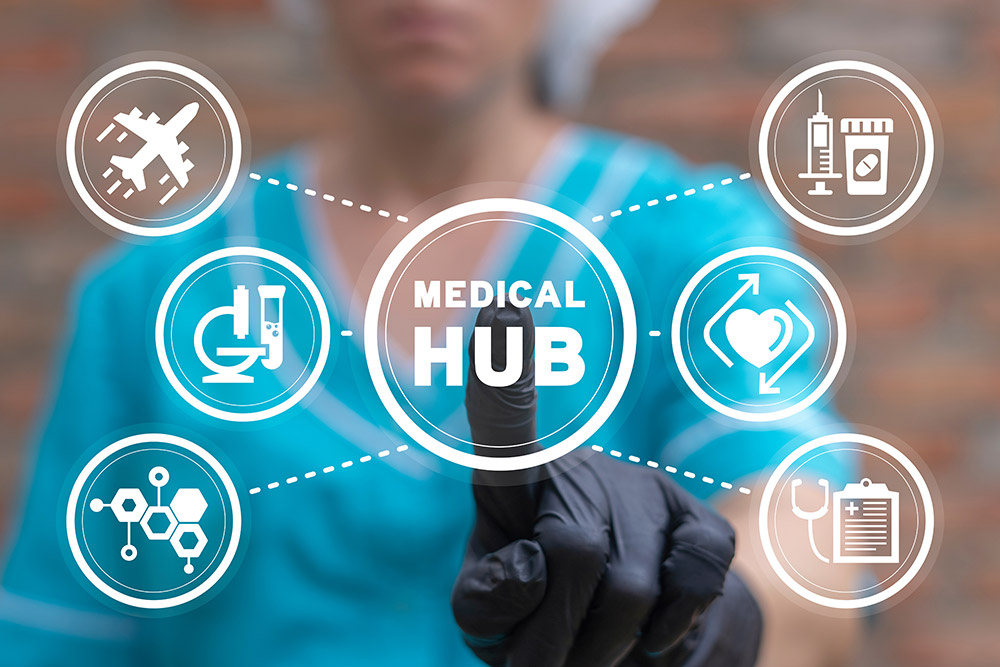Life Sciences Companies Need an Innovation Hub to Thrive
Cities, research institutions, and commercial real estate firms are partnering to develop special districts to innovate for the future.
Q2 2024

Whether you call it a “district,” “ecosystem,” or “hub,” it has proven axiomatic that today’s life sciences activity thrives in concentration, where innovation output — new treatments, startups, modalities — is a function of the power of community. Critically, these dynamic communities, in turn, produce commercial opportunities for large pharmaceutical companies.
As life sciences innovators would agree, new medicines, treatments, devices, and diagnostic equipment don’t arise in isolation. Instead, breakthroughs are far more likely to arise where talent, resources, capital, research institutions, facilities, and physical infrastructure converge. Ultimately, the whole is greater than the sum of these parts — and real estate is the connective tissue enabling a healthy and vibrant ecosystem.
We have witnessed how the right physical environment can support not only the labor, but also the intangible aspects of innovation Leading research institutions and enterprising cities have learned how to work with private-sector partners, including commercial real estate firms, to build places and spaces that make life sciences breakthroughs more likely to occur. Repeatedly, we have witnessed how the right physical environment can support not only the labor, but also the intangible aspects of innovation — the culture of entrepreneurship and creative problem-solving, formal and informal networking, the passion for creating medicines, devices, or treatments that may dramatically improve patients’ lives.
An Example
Philadelphia, for example, has boosted its prominence as a life sciences hub through numerous investments and public-private partnerships (P3s) to create purpose-built life sciences facilities in vibrant, amenities-rich settings.
In 2022, Philadelphia Industrial Economic Development Corporation transformed a blighted former U.S. Navy site into a diverse life sciences community. It partnered with a real estate advisor to create a redevelopment strategy, engage a P3 partner, and attract like-minded life sciences organizations to populate the growing development. Today, it one of the most successful redevelopment projects in U.S. history, home to a community of more than 15,000 employees and 150 employers occupying eight million square feet of office, retail, industrial, research and development, and institutional properties. Breakthroughs are far more likely to arise where talent, resources, capital, research institutions, facilities, and physical infrastructure converge
Philadelphia’s universities are also playing a role in transforming industrial sites into life science innovation districts. For example, Drexel University forged a P3 with Brandywine Realty Trust to transform Schuylkill Yards into a vibrant five-million-square-foot, $3.5 billion mixed-use community that brings together educational and medical life sciences institutions, retail and hospitality businesses, and residents of transit-oriented housing. Meanwhile, Drexel’s neighboring educational institution, the University of Pennsylvania, created a P3 to transform an underutilized former industrial site into Pennovation Works, a dynamic blend of office, labs, and production space focused on life sciences and technology.
It Takes a District
Life sciences industry experts have come to the powerful conclusion that a well-organized, economically and culturally supported hub can generate more marketable innovations than any individual company can produce on its own. With cities, research institutions, and commercial real estate firms working together, it takes a village, or in this case, a district, to create an ecosystem that can spur future innovation.
Project Announcements
BioStem Technologies Plans Boca Raton, Florida, Headquarters Operations
12/06/2025
AstraZeneca Expands Frederick-Gaithersburg Maryland, Manufacturing Operations
11/29/2025
South Korean-Based Nature Cell Plans Baltimore City, Maryland, Production Operations
11/19/2025
Regeneron Pharmaceuticals Plans Saratoga Springs, New York, Manufacturing Operations
11/17/2025
AndHealth Expands Columbus, Ohio, Headqurters Operations
11/14/2025
Taiwan-Based Bora Pharmaceuticals Expands Baltimore, Maryland Operations
11/13/2025
Most Read
-
The Workforce Bottleneck in America’s Manufacturing Revival
Q4 2025
-
Rethinking Local Governments Through Consolidation and Choice
Q3 2025
-
First Person: Filter King’s Expansion Playbook
Q3 2025
-
Lead with Facts, Land the Deal
Q3 2025
-
How Canada Stays Competitive
Q3 2025
-
America’s Aerospace Reboot
Q3 2025
-
Investors Seek Shelter in Food-Focused Real Estate
Q3 2025
